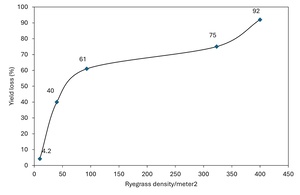Introduction
Italian ryegrass [Lolium perenne L. ssp. multiflorum (Lam.) Husnot] is continuously evolving as a weed species in agricultural systems and riparian areas worldwide, including Alabama. Italian ryegrass is a troublesome winter annual weed species found throughout the U.S. infesting small grain production (Figure 1). Despite its popularity in the Southeast region as a forage and winter cover crop, users should be aware of its genetic potential to escape cultivation and become a difficult to control weed species. The adaptability, rapid growth, and prolific seed production by Italian ryegrass as a weed make it a strong competitor, posing a significant threat to over 300,000 acres of corn and 200,000 acres of winter wheat in Alabama (USDA-NAAS, 2024) and potentially causing severe yield losses in corn (65%), cotton (85%), wheat (92%), and soybean (37%) (Steckel and Bond, 2014) (Figure 2).
Due to wide range of genetic diversity, ability to cross-pollinate, and rapid response to imposed management stresses such as repeated use of same herbicides, Italian ryegrass has now developed resistance to six different herbicide modes of action. These include ACCase inhibitors (WSSA Group 1: diclofop-methyl, fenoxaprop-ethyl, clodinafop-propargyl, pinoxaden, sethoxydim, cyhalofop-butyl, fluazifop, clethodim, sethoxydim), ALS inhibitors (WSSA Group 2: chorosulfuron, sulfometuron-methyl, imazamox, mesosulfuron-methyl, triasulfuron, pyroxsulam, nicosulfuron), EPSPS inhibitors (WSSA Group 9: glyphosate), glutamine synthetase inhibitors (WSSA Group 10: glufosinate), very long chain fatty acid inhibitors (WSSA Group 15: flufenacet), and PS-I inhibitors (WSSA Group 22: paraquat) in the U.S. (Heap 2024).
Current herbicide resistance status in Alabama
Reports of confirmed multiple and cross resistance in Italian ryegrass to several herbicides in neighboring southern states such as Mississippi, Tennessee, Georgia, Texas, and North Carolina threat the sustainability of wheat production in Alabama. Although there have been no official reports of herbicide resistance in Alabama, farmer’s complaints and preliminary data suggest potential resistance to commonly used herbicides. A survey was conducted in summer of 2023 targeting crop as well as non-crop areas in Alabama in which 14 counties (Escambia, Baldwin, Lee, Henry, Dallas, Marshall, Walker, Lawrence, Franklin, Cullman, Limestone, Bibb, Morgan, and Jackson) were sampled. Out of 44 accessions collected and screened for possible herbicide resistance at field recommended rate, 30% were found resistant to pyroxsulam, 18% to glyphosate, 14% to fluazifop, and 5% to clethodim (Figure 3 & 4).
Implications of using Italian ryegrass as a cover crop
Italian ryegrass is widely grown as a pasture crop and is sometimes referred to simply as “rye,” which can also refer to cereal rye (Secale cereale)—another grass crop commonly used and recommended as a winter cover crop. Cereal rye is much easier to control and less prone to herbicide resistance evolution compared to Italian ryegrass. Given the extensive record of herbicide resistance in Italian ryegrass across several modes of action in the U.S. and worldwide, it is advisable to avoid Italian ryegrass as a cover crop. Cereal rye seeds can be distinguished from Italian ryegrass seeds by their solid nature and resemblance to wheat, while Italian ryegrass seeds are hollow and have a distinctive notch at the tip (Figure 5)
Management options
Due to the increasing cases of reduced control and herbicide resistance, it is important to utilize integrated weed management (IWM) strategies that incorporate preventive, cultural, mechanical, physical, biological, and chemical control methods to mitigate the emergence of further resistant biotypes.
IWM: To effectively manage Italian ryegrass, it’s essential to halt the introduction and dispersal of its seeds. Italian ryegrass in ditch banks, turn rows, and field borders should be managed properly to prevent the further spreading of seed by equipment or runoff. Harvest weed seed control (HWSC) presents a promising management option for reducing the soil seed bank of Italian ryegrass as the seed viability of Italian ryegrass typically reduces to 60% within two years.
Tillage: Fall tillage can also be an effective control strategy for Italian ryegrass, particularly in eliminating the initial flush of seedlings, especially when the ryegrass seedlings are small. Moreover, combining fall tillage with spring herbicide applications can efficiently manage resistant Italian ryegrass.
Herbicide rotation and mixes: Chemical control strategies are essential for managing resistant Italian ryegrass populations effectively by employing preemergence and postemergence herbicides with diverse modes of action, implementing sequential applications, and incorporating tank mixes. Using the same modes of action repeatedly may select for weedy biotypes of Italian ryegrass and given it’s a prolific seed producer, it will spread rapidly which over time may result in reduced sensitivity or complete failure of the specific mode of action to control its biotypes. Moreover, always read labels and look for seed traits of the crop before using any herbicide and the appropriate nozzle, spray pressure, and spray volume are essential to achieve better control of resistant Italian ryegrass while minimizing the risk of further resistance development. Table 1 outlines the chemical control strategies available for managing resistant Italian ryegrass.
Conclusion
Italian ryegrass is increasingly a problematic weed species in row crop agriculture in Alabama. Producers should be encouraged to be proactive and apply best management practices and integrated weed management strategies in their operation to minimize the risk of herbicide resistance and the spread of Italian ryegrass. Considering the relatively short seed viability of Italian ryegrass seeds in the soil (Russell 2022), IWM practices should be utilized for 2-3 consecutive years to decrease the weed population and long-term negative impacts on crop yields.

_and_italian_ryegrass_in_non-cr.jpeg)

_limestone_county_and_b)_cullman_cou.png)
__a)_collection_sites_for_italian_ryegrass_acce.png)
__cereal_rye_(right)_--_recommended_as_a_winter_cover_crop.png)
_and_italian_ryegrass_in_non-cr.jpeg)

_limestone_county_and_b)_cullman_cou.png)
__a)_collection_sites_for_italian_ryegrass_acce.png)
__cereal_rye_(right)_--_recommended_as_a_winter_cover_crop.png)